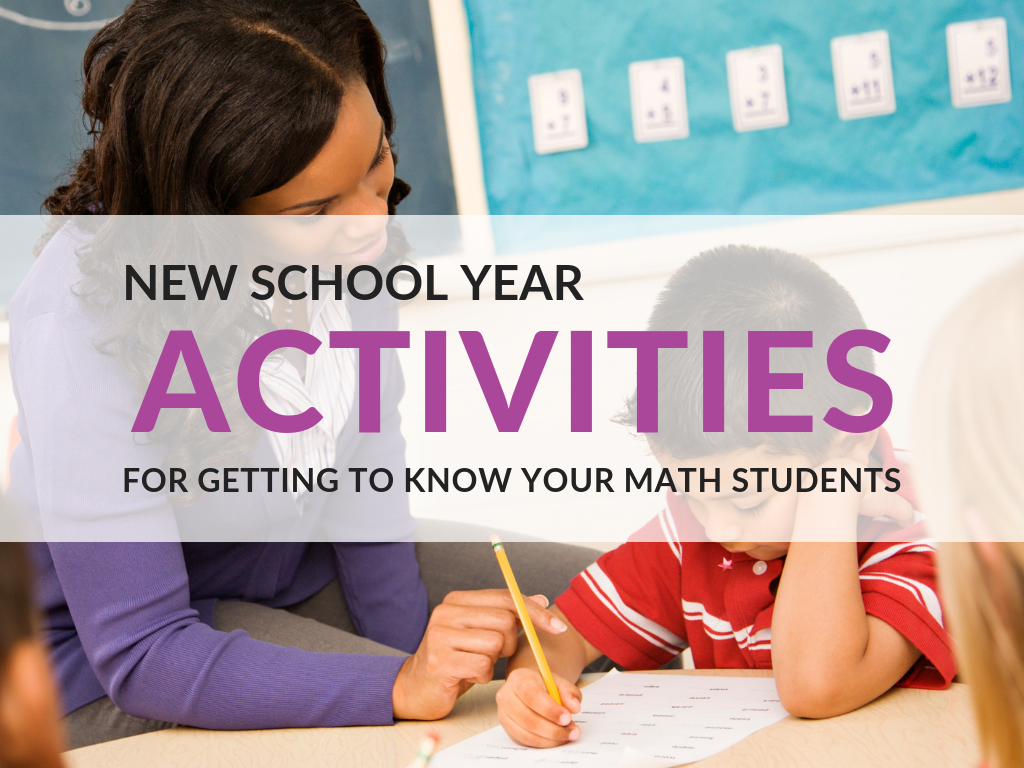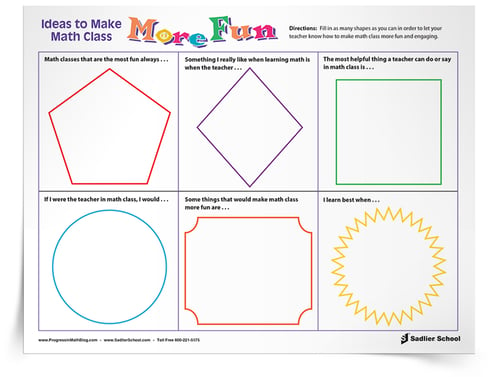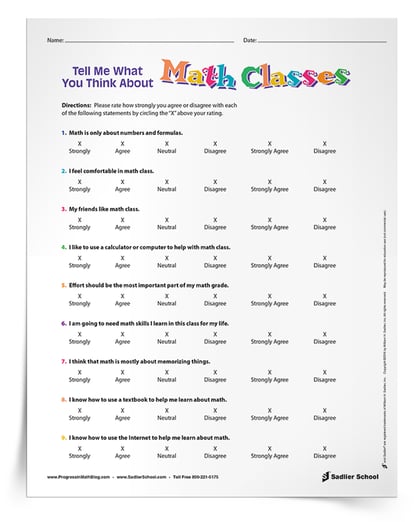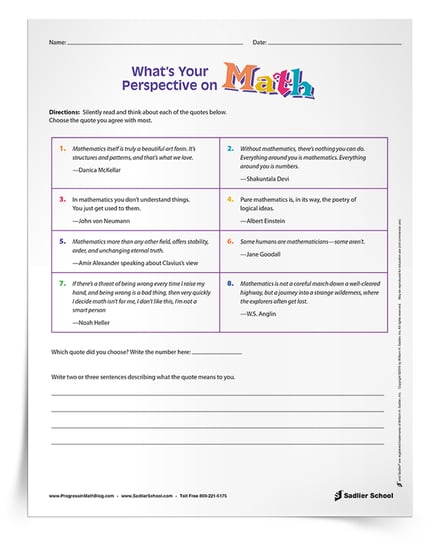July 18, 2024 other-professional-development, other-seasonal
5 New School Year Activities to Get to Know Your Math Students
By: Jeff Todd
As each new year approaches, teachers are faced with the question of how to get started with their new students. While the “how” is important, spending time reflecting on what your students need to know about yourself, your classroom, and your expectations, will likely illuminate a method for delivery. The first day and week will set the tone for the entire school year, so choosing the perfect activities to get to know your math students is critical. The chosen new school year activities will convey your own feelings about math, your values, and your classroom expectations to your students. Every teacher’s goal should be to send this message: “I am interested in who you are and what you think.”

In this article, you will find five activities that can be used at the start of a new school year in both the face-to-face classroom or the virtual classroom.
Developing a nurturing and safe space where students feel like they belong opens the door for students to take risks, learn new skills, and collaboratively engage with one another. Mathematics lessons often rely on productive struggle, perseverance through problem solving, and a growth mindset that enables students to learn from their mistakes. Time and time again, research studies prove that one of the most essential and impactful factors for students' success is the relationship between the teacher and the students. Attendance, academic performance, level of engagement, and improved behavior have all been linked to a positive teacher-student relationship. Optimizing the opportunities across the first few days to set the tone in your classroom and establish relationships can make all the difference for you and your students' success.
The following five tasks offer a starting place for you to get to know and continue to check in with your students throughout the year. They can be used to assess students’ initial thoughts and attitudes about math class, evaluate how they change throughout the year, and help you to identify any additional support you may be able to offer!
If you will be teaching remote, these printable PDFs can be converted via Google Drive so students can type directly into the worksheet. Check out Vocab Gal's steps for converting PDFs so they can be filled in online.
New School Year Activities to Get to Know Your Math Students
These are tools for setting the tone of your classroom, creating a sense of community, and developing an understanding of who each of your students are. By using these activities you will be able to lay the foundation for a safe learning environment, productive mathematical discussions, and collaborative group work from the very beginning of the school year.
#1 Make Math Fun Survey
This survey features a graphic organizer including six geometric figures. Each shape has a different prompt which will give you insight into your students’ prior math experiences and their personal learning styles. To use this in your classroom, download the Ideas to Make Math Class More Fun Student Survey and prompt students to write responses in each of the different shapes. You may encourage students to first respond to the prompts that interest them the most, then move on to the others until they complete all six. Collect their graphic organizers and review your students' responses in order to get to know your students and their thoughts about math class. It is especially helpful to make a copy and keep these on file for you to be able to look back on throughout the year.
#2 Likert-Style Math Survey
This survey will generate meaningful information by having students mark whether they strongly agree, agree, feel neutral, disagree, or strongly disagree with each statement. You may choose to review students' responses by flipping through them or you can enter the results into a spreadsheet. Using a spreadsheet, will allow you to see how your students are similar and/or different from one another, track how their attitudes change throughout the year, and serve as a data source which can be used for self-evaluations. Download the Tell Me What You Think About Math Classes Survey now.
If you are teaching remote, you can create an online poll with these questions for students to answer!
#3 Math Quotes Discussion Starter
The last of the new school year activities for your math class includes a series of eight quotes that you can use as a writing or discussion prompt with your students. These math quotes cover a range of ideas about math from being always-the-same, to being creative. I like opening up the school year this way and finding out what my students really think about math. I want to assess, influence, and even challenge their views of math, helping them to enjoy the subject and to not see it as a required, boring subject. Download the What's Your Perspective on Math? Activity now.
The quotes can be used to start an extended think-pair-share in the following suggested sequence:
-
Hand out the quotes.
-
Call on different student volunteers to read the quotes aloud.
-
Ask students to silently think about the quotes, to choose one that resonates with them, and to write a couple of sentences about what it means to them.
-
Have student pairs share with each other their quotes and why they chose them.
-
Open the discussion up to the class for students to share their view of mathematics and math class.
-
Tally the number of students who chose each quote to summarize the class discussion about the different ways math can be viewed.
#4 Number Talk
By sharing a single number (-2, ⅔, 0, etc.) in an open ended discussion, you will be able to assess what your students remember from the previous year and begin to learn about the comfort and ability level of each of your students. A number talk is a great way for every student to be vocal in the math classroom and for you to get to know the personalities of each of your different groups of students!
To conduct this task, you may use a whiteboard and dry erase markers or a poster paper and markers to save each class’s thinking and display them around the room. Students are to think (no paper and pencil) about what comes to mind when they see the number. Ask them to consider the quantity, operations, representations, etc. depending on what is appropriate for their grade level. After a few minutes of independent thinking, go around the room and allow every student to share an idea. Accept every student’s contribution with a positive affirmation and record them on the board. Throughout the sharing, you may choose to pause and discuss ideas further, connect multiple students' ideas, or ask questions aloud to further provoke thinking.
#5 Math Autobiography
The last of the new school year activities for your math class is an independent activity to allow students to share with you about themselves and their past math experiences. Understanding who your students are and where they are coming from are the roots that allow a teacher-student relationship to blossom. Depending on the amount of time you have and the grade level of your students this task can be quite flexible. The final product can be as elaborate as you would like; some teachers may choose to have students type their autobiographies and then color them or mount them on paper to be hung around the classroom.
Have students reflect and write about some or all of these questions and topics either in class or as homework:
- Describe some of the most memorable moments that you have had related to math both good and bad.
- What do you think about mathematics? If math were an animal, what would it be and why?
- Describe some of the experiences you have had with math teachers both good and bad
- How do you feel while you are in a math classroom? Scared? Nervous? Excited?
- What is something that you struggle the most with while you are learning math?
- What is something that makes math easier to learn for you?
- If you were to define mathematics to someone who does not know what it is, what would you say?
- Tell me anything else that you would like me to know about you!
In Summary
The activities that are used in the first few days of school will set the stage for the relationships you will be able to build with your students and the environment you will be able to create in your math classroom. Using these five activities will help you show your students you are someone who truly cares and help you get to know your students both as people and as math learners.








